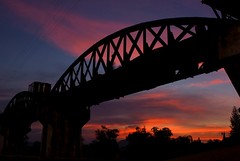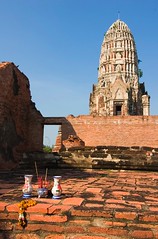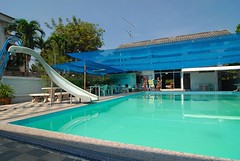Sunday 30 November 2008
Fizzy Offering
Wat Tham is Love?
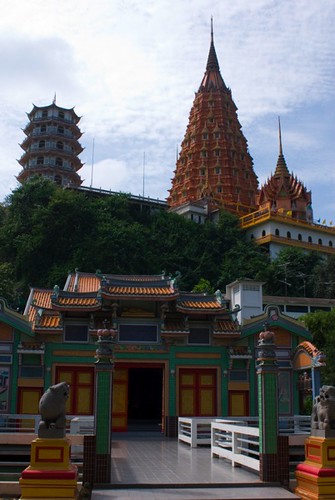
Wat Tham Khao Noi?
As we motored along, I sped while Georgia’s driver took it more slowly for her and the bump, I looked up for the hill and its temples. The only hills I could see where miles away and devoid of any roofs, prangs or chedis. I began to think we must be heading the wrong way, abducted by highwaymen motorcycle taxi drivers taking us deep into woodland to bag our wallets. The photos I had seen of the temples showed three pagodas crowning a steep wooded mountain top that clearly towered over the surrounding land. The guide books talked of a funicular railway to take pilgrims and tourists to the top.
The road took turns in alternate directions. The hills were not visibly getting any nearer so clearly they were more than 6km away. Then, after one final turn to the left the pagodas came into view, barely rising above the nearest banana plantation. What in my expectation had been a cloud-scraping mountain turned out to be a much less lofty hill, one that could easily be at home in Norfolk. We were delivered to the base of the protuberance right at the start of the not-much-larger-than-toy-sized funicular, a track of not more than 100 metres on which ran two silver ‘carriages’ with enough space to take maybe four or five families. We succumbed, shunning the short flight of steps next door for a 10 baht, 10 second shudder up the escarpment and on to the plateau.
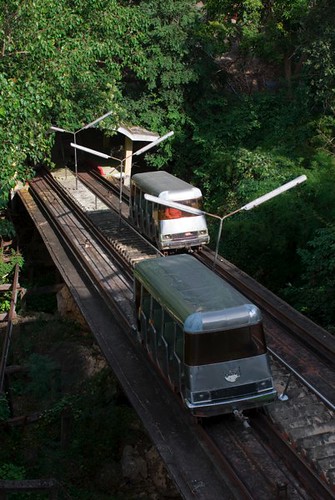
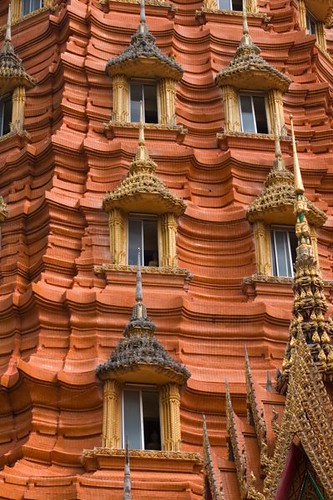
The two temples are one Thai Buddhist and one Chinese Buddhist. The Thai temple - Tham Khao Noi - has a giant, golden mosaic-covered Buddha that sits within a flame shaped canopy next to red-roofed temple halls and two orange pagodas tapering to golden points. No surface is left unpainted, ungilded or devoid of a twist or turn of some form of architectural embellishment. Each pagoda contains numerous Buddha statues in window niches on seven dark floors. The small windows allow in only narrow shafts or light that are hardly augmented by strip lighting. Sometimes two or three Buddhas are stuffed into a niche or a larger group are deposited seemingly randomly on a table. The views down onto the other temple buildings and across vivid green rice paddies to distant wooded hills are those of built and natural tranquillity.
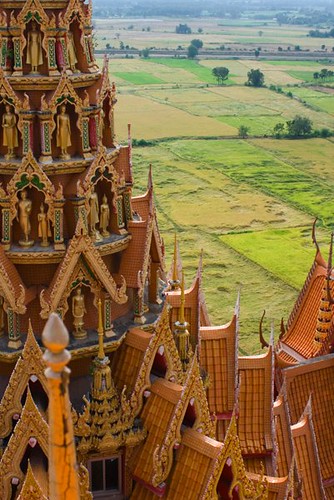

But all the time there is another presence looming. This is the Chinese pagoda of Wat Tham Suew next door. Totally different in style, the hexagonal, vertical-walled pagoda is seven floors of large, flat pastel colours, each floor under a sloping tiled roof so archetypical of Chinese style. Buddha statues could be glimpsed silhouetted in the doors. Inside, a single Buddha statue occupies the centre of each floor and the feeling is of natural light, open, uncluttered spaces that are freshened by gentle breezes. Outside the ornate clutter of the Thai pagodas make architecturally wrought attention-grabbing stratagems less anyone dwells too much within the Chinese pagoda.
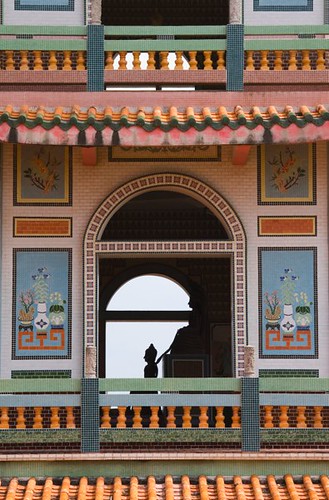
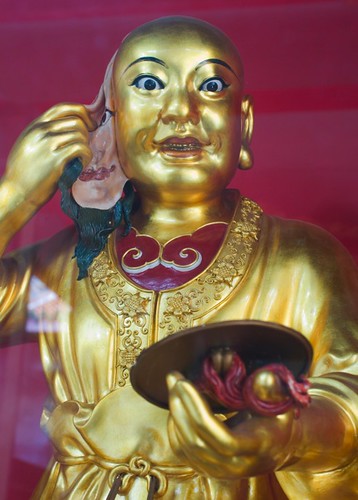
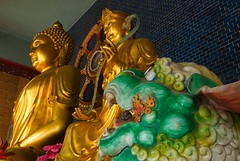
The way up to the Chinese pagoda is not gifted with a funicular, but instead is a series of Escher-like stairways and walkways threading through a number of temples complete with Chinese statues of characters that clearly evoke thought-provoking stories on ways of living. Inside the pagoda, the walls are decked with thousands of tiles, each with a small Buddha image. As we descended back to terra firma we heard chanting and a bell from one of these and saw a lone orange-robed monk praying before one of the Buddhas. The long decay of the bell and the sonorous chant held peace in the air.

Thursday 27 November 2008
Indiana Jones and the Temple of Poon

Buddha in a Cave
We visited one of the many caves in this limestone region of Kanchanaburi. The karst limestone forms teeth-like hills above ground, while below are found tunnels and chambers that prompts the idea that this is what it must be like to travel inside bowels and spines. Some of the caves are used as temples, others have more harrowing histories as Japanese World War 2 POW camps.
We visited Wat Khao Poon, a temple to Buddha and Ganesha and once a Japanese field hospital. After clambering down a flight of steep steps we came into a large, brightly-lit and roomy chamber with statues of the reclining Buddha and the rotund Chinese smiling Buddha. Beyond this is where the fun begins. Snaking and ducking along a series of narrow passages, brings us to one chamber after another. Each passage creeps further and further down into the ground, through broken and weathered limestone that looms into view as angular and bulbous formations akin to bones and bodily organs. Thankfully, very few of the walls ooze dampness.
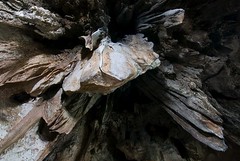
Mighty Ceiling Stalactites
Large fossilised waterfalls spring into each passage and chamber in the form of massive stalactites and stalagmites that cascade from roof to floor in absolute stillness. Some stalactites are ridged into furrows and fins, while others look like petrified ripples on a beach. Some form columns while others flow over the limestone corners and curves. In places, the stillness is broken by a gentle drip of water, showing that the processes of stalactite formation are still busy. Everything else is motionless - apart from us. The pale blue grey whiteness of the limestone is devoid of any colour energy; the warm fetid air is immobile while no sound echoes come back from footfall. But we keep descending; down, down, down between the rock.

Ganesha
This lack of movement, in many ways, makes Wat Khao Poon a perfect place for meditation. Perhaps it is this, and a veneration of natural elements, that brought people to worship down here centuries ago. Each chamber is a temple or shrine. As we clamber through each opening we find statues of the Buddha, Brahma, Shiva and Ganesha set against the background of bent limestone and ribbed stalactites. Some images are dark, others golden, but most are draped in bright orange cloths. They are accompanied by dying flowers and burnt incense, while surfaces are covered in small squares of gold leaf. Each is a testament to an unseen act of worship.
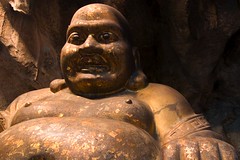
Laughing Buddha
Eventually we begin to climb, the turn in direction coming after the largest chamber with the largest Buddha statue. The air begins to turn a little fresher and at last the white fluorescence of the artificial lights give way to a warmer hue. We look up to see an opening, beyond which the green leaves and branches of a tree striate the blue sky. We return above ground, leaving the underworld once more in peace.
Tuesday 25 November 2008
Bridge Over the River Kwai
The area is very beautiful which belies the terrible past it bore witness too as the Japanese forced thousands of POWs and tens of thousands of South Asian labourers to hand-build a railway line from Thailand to Burma - the infamous Death Railway. Visiting the huge POW cemeteries, of those died building the line through malaria-infested mountain jungle using picks, shovels, dynamite and wheelbarrows is very moving. Even more so, if knowing that many thousands more forced labourers from South East Asia were buried in unmarked graves, any fixed place for the memories of them being lost forever.
Monday 17 November 2008
Trat-a-rat-a-tat
We're now on our way to an island for a couple of weeks holiday and snorkelling before our first antenatal check-up. We've already got advice on which clinics to go to, when, and translations of the questions we want to ask.
Offering to a Prang
Sunday 16 November 2008
Chedi-Chedi, Prang-Prang
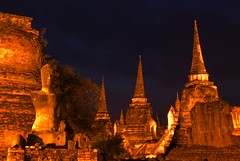
Wat Si Sanphet
The diminutive Thai security guard approached me out of the gathering gloom of dusk, the spotlight casting his giant shadow against the illuminated chedi. We close now he politely said, beckoning me towards the exit. It was sadly time to drag myself away from the magical temple courtyard of Buddha statues, broken columns, white-flowering trees, bell-shaped chedis and towering prangs all brightly lit in yellows, oranges and greens. I had just taken my last photograph of the row of three graceful chedis of Phra Si Sanphet, each topped with spires of ever-diminishing discs, that glowed against the now-black sky. The tour parties had long departed; leaving me to watch the sunset paint the sky red behind the technicolour temples in tranquil solitude. I reluctantly headed for the exit, taking one last glance over my shoulder at the multicoloured wonderland before cycling back to my hotel through the historical parkland.
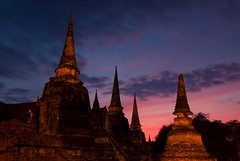
Wat Si Sanphet Sunset
Ayutthaya was founded 700 years ago on an island formed by the confluence of three fast-flowing rivers as the second great royal capital of Siam. Completely encircled by the rivers and criss-crossed with canals, it was aptly dubbed the Venice of the East by the first European explorers to set their eyes on the city in the 1500s. The city was a metropolis capital, religious centre and trading port. Ships regularly visited its riverside wharves from Europe, Indonesia, Malaysia, Japan, India, Persia, Arabia and China while Siamese ships sailed in the opposite directions across the Indian Ocean and South China Sea. The great Chinese naval captain Zheng visited Ayutthaya in 1407 and made a benefaction to the nearest temple to the portside warehouses. Foreign trading communities lived in specially designated residential quarters where they were allowed to govern themselves and follow their own religions. Ayutthaya flourished for 400 years until sacked by the Burmese army in 1767.
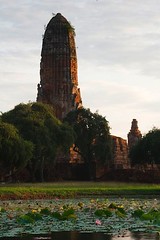
Wat Phra Ram with lotus flowers
The Buddhist Kings of Siam built monumentally beautiful temples, known as wats, to honour their departed fathers. The Burmese destroyed much, decapitating most of the Buddha statues, but the main temple structures survived the flames and hammers. Most of the temples and palaces that remain today are preserved in an historical park of fragrant trees, lotus-filled canals and white-painted bridges that occupies much of the western half of the island. Modern Ayutthaya takes up the remaining half, its streets following the same grid pattern followed by the canals. The city lies on the flat floodplain about an hour and a half drive north of Bangkok.
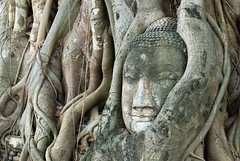
Buddha head at Wat Matathat
The very centre of the Siamese Kingdom was found under the prang of Wat Matathat, a type of temple that lay at the heart of every major Siamese city and under which lay buried a relic of Buddha. Following archaeological excavations in 1956, the relic has been on display in one of the city museums. Matathat is notable for a fallen Buddha head that has been taken up by the twisted roots of a banyan, a Buddhist holy tree. This growing together of nature and art is seen as very auspicious by Thais and it is sometimes decorated with cloth and offerings to request merit from the Buddha.

Nagas and Garuda of Wat Rathchaburana
Next door to Matathat is Wat Ratchaburana which has the best surviving prang in Ayutthaya rising above the trees. Each temple is laid out as a square and aligned on the compass points. The prang is in the very centre and represents Mount Meru, the holy mountain of the Buddhist heaven. Chedis surround the prang, each representing a cosmic plane. Chedis at the four corners stand for the four human universes of physical being. Ratchaburana’s prang still preserves the stucco relief statues of garudas, nagas and other mythical beasts. Robbers unfortunately dug below the prang and made off with a treasure of royal gold but thankfully two of them were caught and some of the gold objects saved.

Wat Phra Ram sunrise
Across the park, the prang of Wat Phra Ram is reflected in the surrounding canals, and best seen at sunrise or sunset. Next to it is Wat Phra Si Sanphet with its line of three chedis. This was the temple of the Siamese royal family and the adjacent remains of the extensive palace lie in manicured lawns.
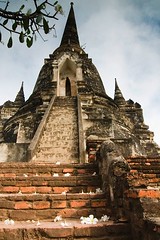
Flowers for a King
These four wats comprise the core of ancient Ayutthaya and are easily visited on foot or by bicycle through the historical park. They all become magical lanterns towering into the night sky when the spotlights are turned on at sunset.
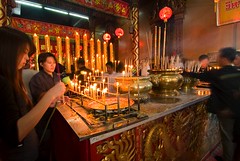
Wat Phanan Choeng
Other ruined chedis and walls pop up on the roadside throughout the modern city. Further away and off the island are three major riverside temples. Wat Phanan Choeng, the temple associated with Zheng He, is to the east of the island. Very much an active working temple, it is bustling with devotees praying in the halls decorated with Chinese script and dragons.

Wat Yai Buddhas doing here?
It is a short distance to the delightful garden temple of Wat Yai Chai Mongkhon, which is again busy with devotees. Hundreds of Buddha status, each draped on orange sashes, line the four walls of the central courtyard and gaze down impassively in front of the central chedi. Climb up into the chedi and you find seven Buddhas covered in gold leaf and set in niches. Thais come to speak merit requests into small pieces of paper, wipe them on the Buddhas then cast them in to baskets. Gardens of flowering trees and shrubs extend outside the courtyard and make a suitable environment for a giant sculpture of a reclining Buddha to enjoy dappled shade.
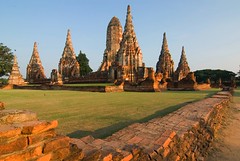
Wat Chai Wattanaram
To the west of the island is Wat Chai Wattanaram, which has more chedis surviving around the central prang than any other temple. Visit in the late afternoon to enjoy the breathtaking sunset then stay to watch it also come alight after dark. Two rarely-visited temples to the west of the island contain an ornate Ayutthaya-style Buddha-as-King statue and the only Burmese temple architecture in the city. These off-island temples can be visited by the more adventurous on bicycle, and Thai drivers tend to be relatively considerate, or by Sawngthaew, the small three-wheeled open-sided taxis that buzz around the roads.
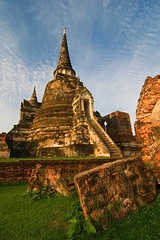
One Chedi of three at Wat Si Sanphet
You can visit all the temples independently, which are open from 7.30am to 6.30pm for an entry fee of 20 to 30 baht at each, or join one of the many tours that take you around all of the main wats in one day or the five illuminated wats at night. Most people spend one hot day or an overnight afternoon/morning visiting the temples. But, if you have more time, slow down to take in only two or three temples a day, wander through the historical park and make sure you visit the Historical Study Centre and the Museum to see the gold objects and Buddha relic excavated from below the prangs of Wats Matathat and Ratchaburana.
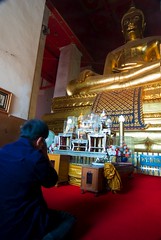
Golden Buddha
The temples are best seen in early morning and late afternoon when the wats take on an orange hue and their architecture is picked out by the shadows of the low sun. Make sure you stay later at Chai Wattarama or Si Sanphet to savour the vibrant colours when sunset mixes with the illuminated wats. That is the time when the colourful magic visits and you won’t want to return to the black and white world outside.
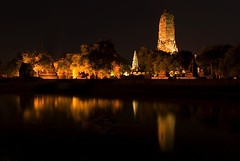
Reflections on a Wat
Thursday 13 November 2008
Poolside in Ayutthaya
We found a couple in big, old colonial courtyard houses in Nicaragua but they were both owned by the same people who had installed what amounted to little more than puddles as part of the backpacker luxury package. Very welcome they were too.
The Ayutthaya pool is much bigger, maybe 10 metres in length, and a one-off in town. It is part of the Sherwood Inn, on one of the roads close to the Ayutthaya ancient ruins. Its very presence epitomises the attitude of the guesthouse manager of providing good, friendly service at a budget price. A double room wil set you back just 280 baht, or 5.50 GB pounds before the exchange rate worsens due to the sinking pound.
Not only is there a pool that is long enough to swim lengths, pleasantly short lengths that is, but there is also plenty of space for yoga, reading and enjoying meals from the great kitchenv Add in a poolside balcony, that has almost become Georgia's private workspace as she completes an editorial contract, and the presence of only five rooms and the Sherwood makes for a very relaxing base to explore the ruins.
Friday 7 November 2008
Buddha on a Mountain
While Georgia went to a local hotel pool, I headed off down the still-quiet streets at 7am to visit the Golden Mount, a temple built on top of a large artificial mound founded on a raft comprising thousands of logs. Strangely surrounded by a market and fair ground, including shooting games, the temple mount is an oasis of calm above the noisy city. A spiralling path winds around the outside of the mount to a temple topped with a red draped golden stupa. Early-rising Thais were already praying and offering flowers and incense to the golden Buddhas inside. Others were making more unusual offerings at the stupa. Marker pens were laid out amongst the flowers and incense for people to write messages on the red cloth cloaking the base of the stupa. Most people would write a message, most likely a wish, take a small orange pillow with a folded cut-out cardboard flower, kneel to offer it to the stupa then circle the stupa three or four times. After they finished, they would pin a 20 baht note onto a criss-cross of washing line suspended above head height.
Lady Boys and Tofu...
http://www.flickr.com/photos/billbevan/sets/72157608730241568/
In our first two days here we have done some of our favourite activities in Bangkok. After checking in to the cheap but very clean Bella Bella Guesthouse in Banlampu, the first thing we did was to grab some fresh stir-fried food from a street vendor. We found a stall specialising in vegetarian food, so we didn’t have to hover over the dried shrimps and say no repeatedly until we had received the food without their liberal application, while enjoying fantastically cooked and delicious tofu with garlic, fried vegetables with tofu and spicy salad with tofu. Next door was a smoothie bar run by two lady boys. All around were pot plants on the street. We then took a ferry down the river to get a cool breeze and away from the traffic noise and followed that with a Thai massage in a tranquil garden. Georgia then called into a 7-11 for an ice lolly. That finished the evening, and a stretch of 32 hours flying without sleep, perfectly. We were in bed after 9pm, jetlag beating.
The next day, Friday 7th, we visited the Royal Barges Museum, a floating delight of sparkling gold leaf, coloured glass and ornate wood carving. There are four graceful boats still kept to in immaculate condition to carry the royal family along the river for major ceremonies. The bowhead of each is carved into a mythical being that carried one of Brahma or Vishnu in Indian epics, including a multi-headed serpent-like Naga, a garuda and a bird. The walk to the museum was along narrow alleys between houses given a glimpse of how Bangkok may have been 50 years ago before the rise of concrete and futuristic skyscrapers. We went on the river again then had a failed evening of shopping and drinking, the mall had closed by the time we got there, the skybar enforced a no sandle dress code. We made up for it with a beer under a tree back on the street of or guest house.

